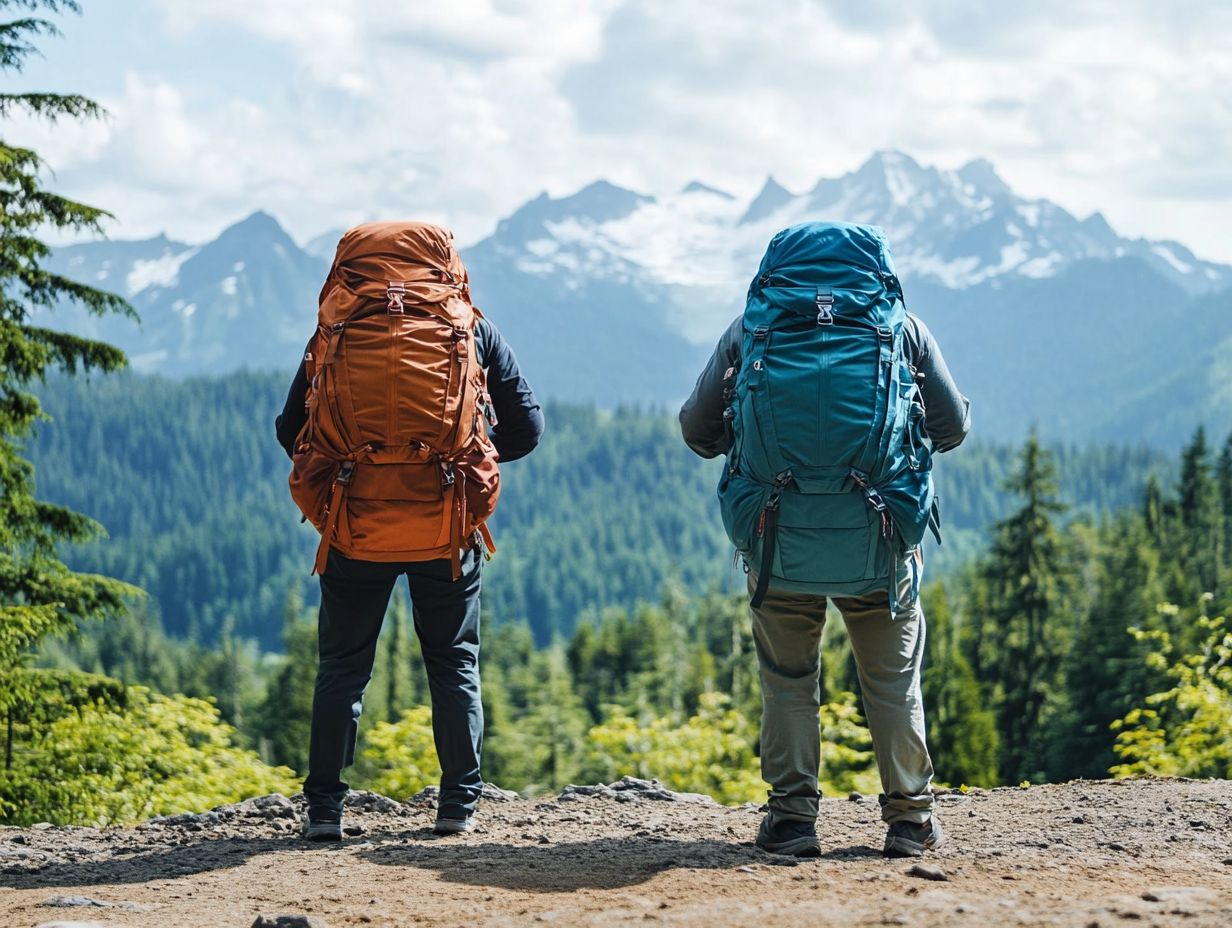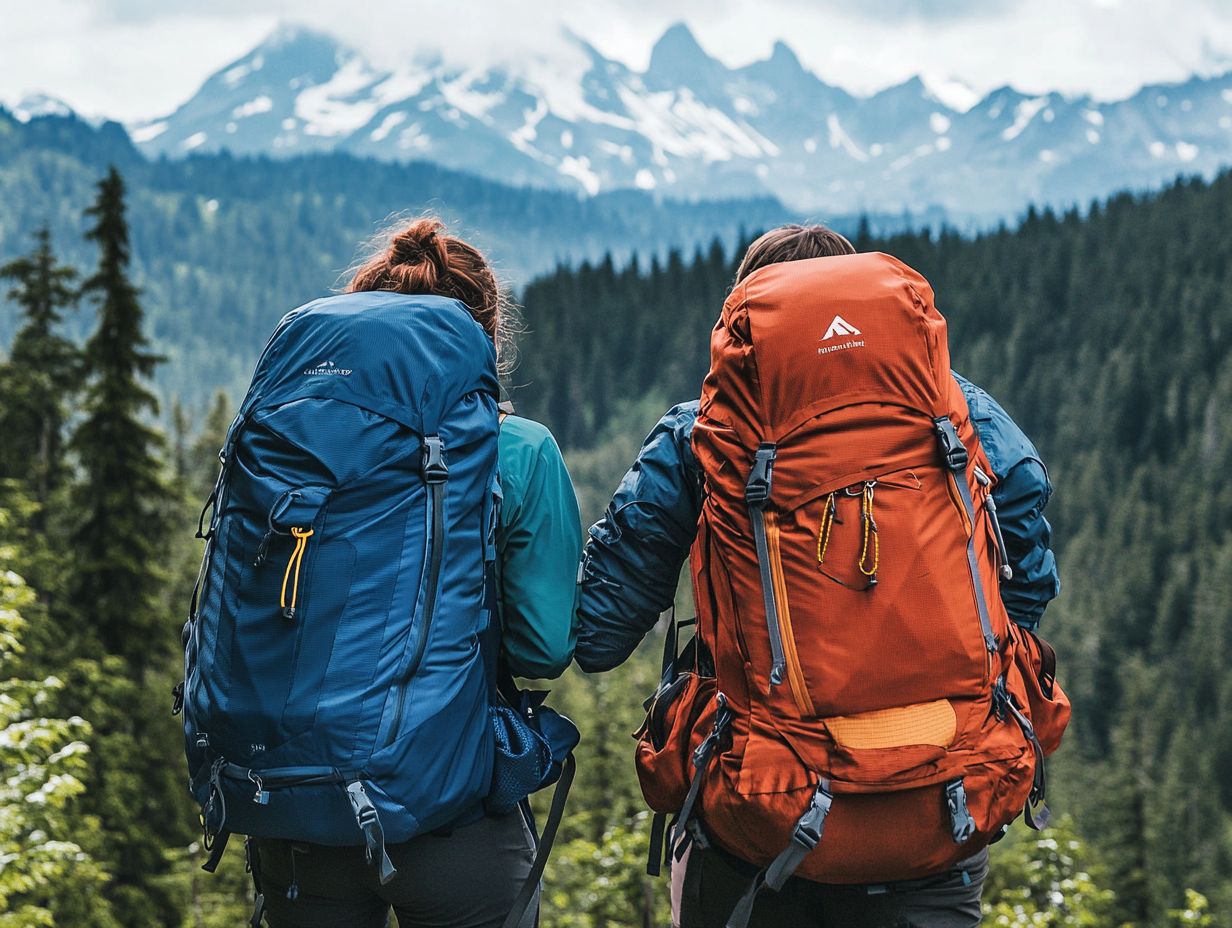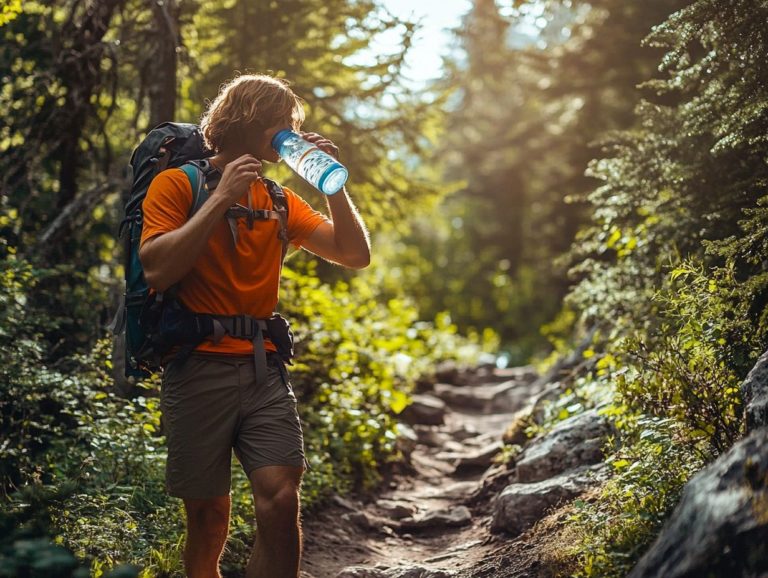How to Choose the Right Backpack for Hiking
Choosing the right backpack for hiking is essential. It can greatly elevate your outdoor adventure.
A well-fitted and thoughtfully selected backpack enhances your comfort and transforms your overall hiking experience into something remarkable.
This guide delves into various sizes and capacities, exploring options like daypacks and hydration packs tailored to your needs. Discover incredible tips to pack like a pro and key considerations, including budget and brand preferences.
The right backpack makes your journey into nature unforgettable!
Contents
- Key Takeaways:
- Importance of Choosing the Right Backpack for Hiking
- Factors to Consider When Choosing a Hiking Backpack
- Different Types of Hiking Backpacks
- How to Properly Pack a Hiking Backpack: Tips for Optimal Pack Organization
- Additional Considerations for Choosing a Hiking Backpack
- Frequently Asked Questions
- What are the most important factors to consider when choosing a backpack for hiking?
- What size backpack should I choose for multi-day hikes?
- What should I look for in terms of comfort?
- Which is better for hiking: an internal frame or external frame backpack?
- What special features should I consider?
- What’s the best way to test a backpack before buying?
Key Takeaways:

- Choosing the right hiking backpack is crucial for a safe and enjoyable trip.
- Factors like size, comfort, and functionality, including the weight of your backpack and how it fits, should be carefully considered when selecting a backpack.
- Daypacks, internal and external frame backpacks, and hydration packs are all suitable options for different types of hikes.
Importance of Choosing the Right Backpack for Hiking
Choosing the right backpack for hiking is essential as it can profoundly influence your comfort, performance, and overall experience on the trail. A well-fitted backpack accommodates your gear seamlessly and ensures balanced weight distribution, alleviating strain during your backcountry travel journeys.
Whether you’re setting off for a single-day adventure or embarking on multiweek expeditions, selecting the perfect pack enhances your ability to navigate diverse hiking styles and terrains with ease. For tips on organization, check out this guide on how to pack a backpack for hiking to ensure that your pack design meets your specific needs.
Benefits of Properly Fitting and Choosing a Backpack
A properly fitting backpack significantly enhances your comfort and performance during hiking adventures by ensuring that weight is evenly distributed across your torso.
When you invest in a pack with adjustable suspension and load adjuster straps, you’ll notice remarkable benefits, including reduced fatigue and improved balance. Additionally, understanding how to choose the right footwear for hiking enhances your experience. The right fit allows for better alignment, enabling you to navigate challenging terrains with greater ease, enhancing your overall performance.
These thoughtful features work to eliminate pressure points, transforming long treks into more enjoyable experiences. By optimizing how the backpack hugs your body, it promotes a smoother gait and boosts your overall efficiency, allowing for longer and more rewarding hikes. To enhance your hiking experience even further, consider learning how to choose the right hiking trail. This design truly underscores the importance of comfort for outdoor enthusiasts like you, ensuring you perform at your best while carrying essential gear.
Factors to Consider When Choosing a Hiking Backpack
When selecting a hiking backpack, it s essential to consider several key factors to ensure you choose the perfect option for your specific needs. Pay attention to pack size, pack volume, and the type of material used in the pack design. Each element plays a crucial role in your overall comfort and functionality on the trails.
Size and Capacity
The size and capacity of your backpack, measured in liters or cubic inches, are essential factors in determining how much gear you can carry on your hiking adventures while maximizing your pack capacity.
Choosing the right pack size primarily hinges on the duration of your outing. For day hikes, you’ll want a smaller capacity backpack typically between 15 to 30 liters with plenty of space for water, snacks, and essentials. If you’re gearing up for a multiweek expedition, you’ll need a larger pack in the range of 50 to 80 liters to fit in your sleeping bag, cooking gear, and extra clothing; this is critical for effective weight carrying. Additionally, if you plan to relax in the great outdoors, consider checking out how to choose the right hammock for camping to enhance your experience.
By understanding your loadout and the type of gear you intend to bring, you can select a pack that strikes the perfect balance between comfort and functionality, making your trek both enjoyable and efficient.
Get ready for your next adventure. Choose your backpack today!
Comfort and Fit
When selecting a backpack, comfort and fit are essential. An improper fit can lead to discomfort and fatigue on the trail; ensuring a proper fit is crucial.
A well-fitted backpack should have adjustable components like shoulder straps and a hip belt. These are vital for spreading weight evenly across your body, reducing strain on areas like your back and shoulders. This balance allows for a more enjoyable backcountry adventure. Additionally, it’s important to consider how to choose the right hiking partner for your trips.
Measuring your torso length is key to finding a pack that aligns with your body’s natural contours. Knowing your hip circumference also helps ensure a snug fit around the hips, enhancing stability.
By prioritizing these adjustable features, you can greatly enhance your comfort today, extend your outdoor excursions, and enjoy your journey into the mountains without the burdens of an ill-fitting pack.
Features and Functionality

The features and functionality of a backpack can elevate your hiking experience by offering enhanced organization and easy access to your gear. This is critical for efficient packing.
With well-designed elements, essential features like pack pockets and compression straps ensure that everything from water bottles to trail snacks is easily accessible and securely stowed. These compartments help distribute weight evenly, easing strain during long treks. Additionally, if you’re planning to spend a lot of time outdoors, consider how to choose the right hat for hiking to protect yourself from the elements. A backpack with waterproof capabilities and a cover protects your essentials against unexpected rain, letting you immerse yourself in the adventure ahead without worry.
When you find the right mix of functionality and organization, you not only boost your comfort but also enrich your overall outdoor journey.
Different Types of Hiking Backpacks
Hiking backpacks come in various types, each crafted for specific purposes and hiking styles. Whether you prefer ultralight packs for minimal adventures, traditional packs for longer journeys, or hydration packs for easy access to water, quality outdoor equipment is available to meet your needs.
Daypacks
Daypacks are compact backpacks designed for short hikes and everyday use. They feature a lightweight construction and generous storage for your essentials, making them perfect for quick trips.
These versatile packs typically range from 15 to 30 liters in size, striking a balance between carrying enough gear and maintaining mobility. Weighing just 1 to 3 pounds, they are built for effortless navigation along trails.
Whether you’re on a day trip or exploring the urban landscape, daypacks often include compartments for your water bottle, snacks, and even an extra layer for changing weather.
As you tackle steep inclines or enjoy a leisurely stroll, the daypack becomes your trusty companion. It allows you to embrace spontaneity without the cumbersome weight of larger packs, ensuring maximum comfort.
Internal Frame Backpacks
Internal frame backpacks feature a supportive frame that hugs close to your body, enhancing how weight is spread across your body and improving overall performance.
This design allows you to carry your load more efficiently, making it easier to navigate rugged terrain. The closer fit minimizes swaying, providing a stable platform that adapts to your movements, whether hiking uphill or trekking across rocky paths.
You ll feel less strain on your back and shoulders, allowing for longer journeys without discomfort. With better ventilation and a lower center of gravity, these packs offer exceptional comfort and boost your confidence, empowering you to tackle challenging landscapes while keeping your gear secure and organized.
Think about what features matter most to you on your next hike!
External Frame Backpacks
External frame backpacks boast a sturdy frame that enhances ventilation. This design supports the carry of heavier gear on those longer excursions, making them perfect for backcountry travel.
This design promotes air circulation, reducing that pesky sweat buildup during your hikes. It also allows for easy access to your essential equipment.
With your gear neatly organized on the outside of the pack, you can quickly grab what you need without having to rummage through layers of clothing or supplies. These backpacks truly excel on extended outings, ensuring comfort and ease.
They evenly distribute weight across your torso, minimizing strain on your back. This clever engineering gives you the power to maintain your energy levels while tackling various terrains, making your journey far more enjoyable.
Hydration Packs
Hydration packs are tailored backpacks designed specifically to carry water reservoirs. They are an outstanding choice for keeping hydrated during short hikes or intense activities, especially during summer adventures.
These packs boast a sleek design that emphasizes lightweight construction. This allows you to move effortlessly without the cumbersome weight of traditional hydration systems.
With adjustable straps and breathable materials, they provide both comfort and efficiency for your trail runs, mountain biking, or long-distance walks. When choosing the right gear, don’t forget about your feet; learn how to choose the right hiking socks. The thoughtful incorporation of multiple compartments not only keeps the reservoir secure but also offers ample space for your essentials like snacks, maps, or first-aid kits.
This ensures you’re fully prepared for any adventure. Plus, with the convenience of a bite valve, you can sip hydration quickly and seamlessly, keeping your focus on enjoying the great outdoors.
How to Properly Pack a Hiking Backpack: Tips for Optimal Pack Organization

Packing your hiking backpack correctly helps balance weight and organizes your gear effectively. This attention to detail can elevate your hiking experience, allowing you to traverse trails with ease and comfort.
Tips for Efficient and Balanced Packing
To achieve efficient and balanced packing, prioritize placing heavier items closer to your back. Distribute weight evenly throughout your backpack.
This approach enhances your comfort during the journey and alleviates strain on your body as you navigate diverse terrains. It’s essential to organize your items based on how frequently you ll need them.
Keep essentials like snacks and maps easily accessible in outer pockets. Consider using packing cubes or compression sacks to streamline your gear management.
This makes it simple to identify and retrieve items quickly. Don t forget to utilize vertical space and pack strategically to prevent your belongings from shifting around.
By thoughtfully assessing your packing methods, you can ensure a more enjoyable and pain-free adventure.
Additional Considerations for Choosing a Hiking Backpack
When choosing a hiking backpack, it’s crucial to consider factors beyond just appearance. The price, brand reputation, and warranty options can greatly impact your purchase decision.
Taking the time to evaluate these elements ensures that you invest wisely in gear that meets your needs and stands the test of time.
Price and Budget
Setting a budget for your hiking backpack is crucial, especially since prices can fluctuate significantly based on features, materials, and brand reputation.
As you evaluate your options, remember that while choosing a more affordable model might seem like a wise financial choice at first, it could lead to higher replacement costs down the line if that backpack can t handle the rigors of the trail.
Thus, considering a reliable backpack with quality construction and durable materials is invaluable in the long run.
By investing a little more upfront in a backpack that aligns with both your budget and quality expectations, you ll enjoy enhanced durability and comfort. Don’t wait choose the right backpack today for your next adventure!
Brand and Warranty
Choosing a well-known brand for your hiking backpack guarantees quality and durability. A solid warranty offers peace of mind.
When you choose a reputable brand, you gain assurance of reliability and a commitment to high standards. Brand reputation reflects thorough testing and quality control.
Warranties demonstrate a company s confidence in its products. They cover manufacturing defects and may extend beyond typical periods, reinforcing your sense of security.
Frequently Asked Questions
What are the most important factors to consider when choosing a backpack for hiking?

When choosing a hiking backpack, consider its size, weight, comfort, and durability. These factors affect how well it will meet your hiking needs.
What size backpack should I choose for multi-day hikes?
For multi-day hikes, select a backpack with a capacity of 50-80 liters. This size allows you to carry all necessary gear without excess bulk.
What should I look for in terms of comfort?
Comfort is key when selecting a hiking backpack. Look for padded shoulder straps, a cushioned back panel, and a waist belt to evenly distribute weight.
Which is better for hiking: an internal frame or external frame backpack?
This choice depends on your preferences and hiking style. Internal frame backpacks are sleek and ideal for off-trail hiking, while external frame packs better support heavier loads on-trail.
What special features should I consider?
Consider multiple compartments for organization, a built-in rain cover, and easy-access water bottle pockets. A hydration bladder-compatible design can also be beneficial.
What’s the best way to test a backpack before buying?
To test a backpack, try it on with weight and walk around the store for at least 15 minutes. This helps you gauge comfort and fit. Ask store staff for tailored recommendations too!





